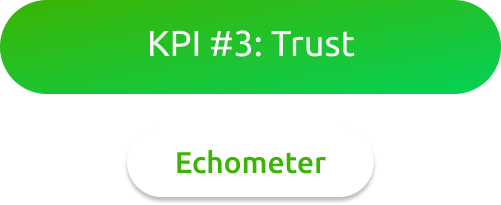Table of Contents
Scrum masters are like soccer coaches. They make sure that the team successfully completes the right tasks at the right time. Most importantly, make sure that the team is satisfied during the process. This way, they ensure that the entire team - i.e. the department or the organization - achieves its goals.
But how can Scrum Master performance be evaluated? As with soccer coaches, the question for Scrum Masters is what part they play in the success - or failure - of projects. So how can you measure how well a Scrum Master is leading their team? We take an in-depth look at how you can evaluate Scrum Master performance and which KPIs are relevant.
Isn't a single KPI enough for Scrum Master Performance Review?
The success of a company usually depends on the value of the product supplied and how satisfied customers are with it. These two factors are decisive for how often a product is purchased. Doesn't a Scrum Master therefore have to be measured exclusively on this basis?
Or couldn't you simply conduct Scrum Master performance appraisal by checking whether Scrum Masters are obsolete? After all, if they get the team to work in a self-organized way, evaluate themselves, and put out an excellent product, they have fulfilled their goal. They are then - at least in theory - obsolete.
If you want a quick and simplified solution, then the answer to both questions is "yes".
However, this only scratches the surface of a Scrum Master Performance Review. To find out where Scrum Masters are generating value, you need to look at KPIs that go beyond that.
This way, you uncover where Scrum Masters are getting the most out of their work - and where they can still improve. This has an impact on the performance of the team and the value of the end product. In turn, this has an impact on customer satisfaction and thus on revenue for your company. Now, let's get into the details!

Scrum Master Performance KPI #1: Sprint Goals Delivery
The KPI Sprint Goals Delivery reveals whether a team achieves its sprint goals on time. The decisive factor here is whether it can consistently meet the goals set by the development team (DEV) and product owner (PO).
To measure Sprint Goals Delivery, you can use these metrics, for example:
Burn Down Charts: Burn down charts graphically represent how much work is left to do compared to the total work in the remaining time. Since the development team maintains the charts daily, you get insight into whether a sprint or project is on schedule. You can see how fast a team is working and how well they can estimate their tasks.
Burn Up Charts: Burn Up Charts show you how much work has been completed compared to the total work. They include changes to the scope or scale of a project. Like burn down charts, they provide insight into how quickly a project is progressing. They thus allow forecasts for further progress.
Predictability: Predictability measures the ratio of "planned" to "completed". In doing so, the metric documents how much work a team committed to at the beginning of the sprint and how much they completed at the end of the sprint.
Tools like Jira, Rally and Version One generate helpful diagrams like Burn Down Charts automatically.

Scrum Master Performance KPI #2: Continuous Improvement
"Continuous Improvement" stands for the goal of an agile team to continuously develop and improve. Pursuing this goal is one of the key responsibilities of the Scrum Master as the person who is conducting agile retrospectives - the key ceremony in agile. You can evaluate "continuous improvemeng" looking at some of the following metrics:
Team interaction
As a facilitator, coach and servant leader, the Scrum Master must ensure that team members interact with one another in healthy way. This metric is more subjective than others. However, it shows how things stand with team communication and thus with team success. For example, you can measure the interaction through observations and team feedback in retrospectives.
Velocity
Velocity measures how quickly a team delivers results based on subjective estimates. This makes the KPI a rough measure of productivity that should be treated with caution. Because the measure is so subjective, few deductions can be made from it. Nevertheless, it is practical and can be taken into a retrospective as one of several indications for targeted reflection. By the way, more information on this can be found in this article: A comparison of 25 agile metrics and the best agile metric.
Dealing with impediments
If obstacles and impediments arise in processes, Scrum Masters are responsible for removing them. You can measure how effectively Scrum Masters are solving them through using a "impediment log". You can create a simple Jira page for this, put down larger and smaller impediments there and take them with you to the retrospective on a regular basis.
Customer satisfaction
Ultimately, a constant increase in the quality of your teamwork also has an impact on the final product and thus customer satisfaction. Customer satisfaction is therefore –, as already stated at the beginning –, also linked to the performance of the Scrum Master. I'll show you below how you can measure this (see "Delivering Value").

Scrum Master Performance KPI #3: Trust
Team members who trust each other work more efficiently. It is that easy. Trust is therefore one of the most important characteristics of a healthy team and thus also of the work of a Scrum Master. In order for trust to develop in teams, scrum masters must above all exemplify trust. To do this, they have to lead their team in a servant manner, again, “Servant Leadership” before.
One model you may know, that is correlated to "trust", is the 5 Scrum values: Courage, Respect, Focus, Openness and Commitment. They can be of great help when trying to improve trust. Measuring them - and trust itself - is not easy without tools. Because: Those metrics are often subjective. However, you can achieve a certain objectivity by continuously observing your team, writing down situations and observations and thus having indicators of trust that you can bring into the retrospective – in order to then work on the topics.
By the way, this is exactly the goal of the software tool: Echometer. It helps you to measure various Outputs & Outcomes of your Scrum Master performance, making them visible in our Echometer dashboards. And at the same time integrating them into your retrospective to facilitate the improvement process around them.
By the way, you can find examples of this in the linked article: 5 examples of outputs & outcomes from retrospectives.
You can have a brief look into our Scrum Master Performance tool Echometer brings you this video from our co-founder (Scrum Master & Psychologist) Christian: 2 minute video. Take a look, I can highly recommend!
To make it short, one of the most important mechanisms of the tool is the following: The outcomes of retros are regularly measured – and discussed in so-called Health Check Retros.
An indication of Scrum Master performance is, for example, whether the 5 agile Scrum values are implemented, visible in the daily life of the team. Do the appropriate retro to make this measurable! This is what it looks like in Echometer. Feel free to take a look, you might even try it out with your team:
Note: This retrospective format asks for agreement with the given Health Check items on a scale.
- Courage: We value people showing courage.
- Respect: We value each other’s ideas, even when disagreeing.
- Commitment: Every team member is committed to follow through on what they have promised.
- Focus: We don’t allow ourselves to be distracted from reaching the sprint goal.
- Openness: We are open to constructive feedback and grow from it.
Scrum Master Performance KPI #4: Team Happiness
Like "Trust", "Happiness" – i.e. team satisfaction – is a relevant metric to measure Scrum Master performance. This is because two important preconditions for how well team members can perform are: Morale and happiness. In practice, this means that if Scrum Masters ensure that employees are satisfied, they are also likely to do a better job.
To measure satisfaction, you can observe employees and regularly ask how they feel in the team and with their work. You can also put this into figures using the Echometer software tool. The results are discussed in retrospectives and action items are derived based on the psychological impulses of the tool.

Scrum Master Performance KPI #5: Delivering Value
One of the most important Scrum Master performance goals - or actually the goal of the team and your organization - is to deliver as much value as possible to the customer with your product. You can use these metrics to determine if you've succeeded:
Customer reviews
Customer reviews give you a precise insight into how satisfied buyers are with a product. This shows you what value a Scrum Master has indirectly created with his team. You can collect feedback from customers using tools such as SurveyMonkey.
Usage statistics
Products typically have mechanisms that are measuring their usage. While increased product usage is no guarantee that customers are satisfied with a product, it is still an indicator of how good a product has become and thus how much value has been generated.
Most Agile Coaches and Scrum Masters run in circles...
...fixing superficial symptoms. Time to use psychology to foster sustainable mindset change.
Support inquiries
If you evaluate the number and kind of support requests, you will get a picture of the problems and possibly bugs that a finished product or increment has. Based on this, you can also draw conclusions about the generated value and its quality.
Product sales
Ultimately, a product should and must generate sales so that the team can be remunerated. High revenue, especially in comparison to the competition, could therefore also be an indicator of a high product value. If available, you can take into account sales figures. However, the relationship to Scrum Master performance is certainly less strong here than, for example, the relationship to trust in the team.

Conclusion on Scrum Master Performance Evaluation
A Scrum Master Performance Review only seems difficult at first glance. In practice, however, you can fall back on numerous metrics with which you can draw conclusions about the Scrum Master performance.
These metrics are closely linked to the Scrum Master Performance Goals. Because: Even for Scrum Masters, the KPIs are an important indicator of how your project is progressing. It may sound obvious, but to be clear: Team Happiness, Customer Satisfaction and Delivering Value are therefore not just KPIs for evaluating Scrum Master performance, but are also examples of the core goals of a Scrum Master's work.
Many tools that you already use for an agile way of working (Jira & Co.) automatically provide you with a few relevant reports and analyzes in order to carry out a Scrum Master Performance Evaluation. That means: in the best case scenario, you have little effort to get a feeling for the performance.
If you not only want to measure Scrum Master performance, but also want to develop your entire organization, you should take a look at our free eBook: 12 Team workshops from a psychological perspective.
The workshops are aimed at one thing above all: developing the agile mindset. What can also help you with the latter is our retro tool Echometer, which we developed based on psychological knowledge. You can find more info about it in our post: comparing 7 smart retro boards.








